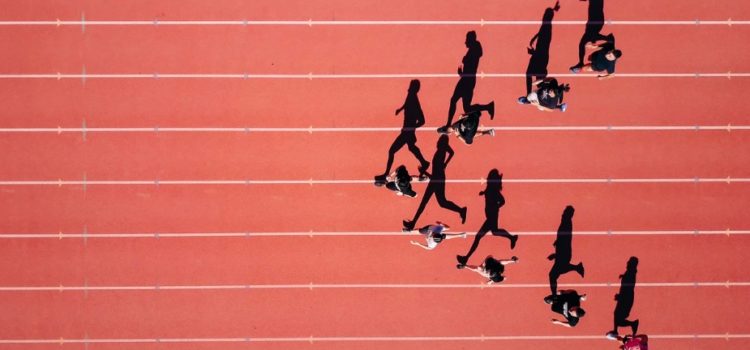

This article is an excerpt from the Shortform book guide to "The Sports Gene" by David Epstein. Shortform has the world's best summaries and analyses of books you should be reading.
Like this article? Sign up for a free trial here .
What are the reasons for the gender performance gap in athletics? Can men and women compete equally in sports?
According to David Epstein, the author of The Sports Gene, gender differences in sports are a decisive testament to the power of genes in determining athletic ability. Because athletic ability is at the mercy of genetics, Epstein argues, women are unlikely to surpass men in most sports.
Here’s why men and women can’t compete in sports at the same level.
Differences at the Elite Level
Until very recently, women’s records in running events were gaining rapidly on men’s, and Epstein notes that it looked to some like male/female differences in running performance might disappear. He discusses a 2002 article in the science journal Nature, and another in 2005 from the British Journal of Sports Medicine proposing that women would soon close the performance gap in running events. This was a logical projection based on side-by-side comparisons of men’s and women’s records. Women’s world records were getting faster at a much greater rate than men’s. If the rates were assumed to be relatively constant, then female runners would eventually catch up to and surpass men.
Looking at running data alone, however, does not tell the whole story of the gender differences in sports. Epstein explains that cultural factors can likely account for a great deal of the steep improvement in women’s performance. Men and women did not even have the same track and field events until 2008, and historically women have certainly not been given the same training opportunities as men. After the surge of the last few decades, women’s running records today have hardly advanced at all, while men’s are still advancing slowly. (Another factor that may account for some of the women’s records in sprint and power events from the 1980s was the illegal use of testosterone (steroids) in female athletes from Eastern Bloc countries during that time period).
The reality is that many female world record holders would not even qualify to compete in the same Olympic events against men. And some of the top female athletes in their sport can be bested by high school boys. Statistically, those women, of whom there are many, who can outperform the average man in sports are the exception.
Epstein cites innate physiological differences between men and women as the reason women are unlikely to best men in most sports. We will look at some of these differences next.
| Women Best Men in Other Measures of Strength Research has shown that from birth to death, women are ‘tougher’ than men in ways that science has yet to explain. Even at birth female babies have higher survival rates than males. As adults, women better survive 12 of the 15 leading causes of death and are older than men at the onset of common diseases such as cardiovascular disease and hypertension. Women also survive longer than men. In 2017, 42 out of 43 supercentenarians (people who live past 110) were women. Women also survive infections better than men. Evolution may explain much of this toughness. Epstein suggests that our female evolutionary ancestors were not as likely as men to participate in the most physically demanding or intense aspects of society. But this may not be true. As we learn more about ancient humans, anthropologists are discovering that the notion of women tending to the home while men hunted, gathered, and traveled long distances is flawed. It appears that women not only hunted and worked alongside men, but they had to do so while pregnant, nursing, and physically carrying young children. In this more modern vision of our female ancestors, it makes sense that natural selection would have developed an extra level of ‘toughness’ in women. |
Differences Explained by Physiology
In general, men throw harder, run faster, and jump higher than women.
(Shortform note: This is not to suggest that if you were to line up a man and a woman the man would always outperform the woman. These differences occur on the level of a population and are based on statistical averages.)
- On average men are three standard deviations more powerful than women when it comes to throwing ability. Epstein notes that if a population were sampled at random, 998 men out of 1,000 would be able to throw harder than the average woman.
Epstein concedes that cultural expectations and stereotypes may account for some of the difference in throwing ability, but in aboriginal populations where both sexes grow up throwing for hunting and combat, researchers found that boys were still able to out-throw girls. Additionally, 87% of boys were better than girls at tracking and catching flying objects.
- As additional evidence that culture alone cannot explain throwing differences, girls who have a condition that results in extra testosterone during fetal development end up throwing more like boys.
Across running events, men are about 11% faster than women. And, on average, men are able to jump 19% farther than women in the long jump. Differences between male and female physiology largely explain these differences.
- Men are taller and heavier than women
- Men have relatively longer arms and legs
- Men have bigger hearts and bigger lungs
- Men have denser bones which can support more muscle
- Men have more narrow hips, which makes running more efficient. (Shortform note: This is a contentious topic and research does not give a definitive answer about whether energy is indeed lost in runners with wider hips.)
- On average men have 80% more muscle in their upper body and 50% more muscle in their legs than women.
| Swimming: The Smallest Performance Gap Epstein notes that the smallest gap in Olympic events between men and women is in distance swimming events, with women coming within 6% of men in the 800m swim. In long open water swims, the gap between women closes and even reverses. Studies of finishing times from the English Channel, Catalina Channel, and Marathon Island Swim over several years found that women were as fast as, and more often faster, than men in these events. One possible reason for these findings is that women generally have a higher body fat percentage than men, and they are better able to utilize that fat as a fuel source over long distances. More body fat can also mean more buoyancy for women in the water, as well as more insulation during cold open water swims. The same trend seems to hold in ultra-running. An article in The New York Times discusses how in extremely long races, male physiological advantages become less relevant. In ultramarathons, in which athletes run up to 200 miles over multiple days, it seems that mental toughness and psychological fortitude allows women to run alongside and even beat their male counterparts. The article highlights Courtney Dauwalter, who has become a celebrity in this sports niche and frequently bests the entire field of male athletes. |
Differences Explained by Evolution
The differences between men and women have their roots in our species’ evolution. Humans are a sexually dimorphic species. This means that males and females of the same species display different characteristics. Epstein notes that the difference in strength between men and women is similar to the difference in strength between male and female gorillas. While we may think of ourselves as ‘more evolved’ than our primate ancestors, it has not been very long since our species’ behavior looked very similar to the behavior we see in wild animals.
In our very recent evolutionary past, men were violently competing against each other to earn the ‘rights’ to women. Males that were stronger and better able to physically fight off other males had more access to breeding opportunities. Anthropology tells us that in hunter-gatherer societies, 30% of men were killed by other men. There is also evidence that we have fewer male ancestors than female ancestors. As Epstein explains, this suggests that the most physically imposing men were able to establish dominance and ‘claim the rights’ to multiple women.
| Sports as a Platform for Male vs. Male Competition As Epstein discusses, it was not long ago in evolutionary terms that our male ancestors engaged in hand-to-hand combat and violent competition (both one-on-one and with a tribe) on a regular basis. While outright violence may be less prevalent, and at least less socially acceptable, in modern culture, some researchers suggest that organized sports offers an outlet for men to express an innate proclivity for physical competition. The authors of a three-part study on male and female participation in organized sports highlight three theories for why sports (with particular emphasis on team sports and sports where skills can be seen as combat-related) may hold special appeal for men. Sports serve as a modern counterpart to courtship rituals in nature and offer men a way to display their physical attributes. Sports allow men to compete for social status in a safer and more controlled way than outright combat. Sports serve as a way for men to “train” for physical activities such as hunting and combat (in modern society the need to use this training may never arise, but the innate desire to train may still be present.) The authors found a difference in participation rates between men and women in organized sports, and team sports in particular, with men choosing to participate more than women. They note that these findings should be viewed in the context of other cultural factors such as male/female gender norms and the encouragement and access to sports that girls receive. The above study’s findings are supported by another study of 50 societies around the world, that also found universally more male than female participation in sports. However, the cross-cultural study did find that the gender gap was smaller in non-patriarchal societies, supporting the idea that culture plays an important role. |

———End of Preview———
Like what you just read? Read the rest of the world's best book summary and analysis of David Epstein's "The Sports Gene" at Shortform .
Here's what you'll find in our full The Sports Gene summary :
- A look at how our genes play a determining role in our success in sports
- Why practice doesn't always guarantee success
- The fortuitous gene pairings that can lead to elite athleticism






